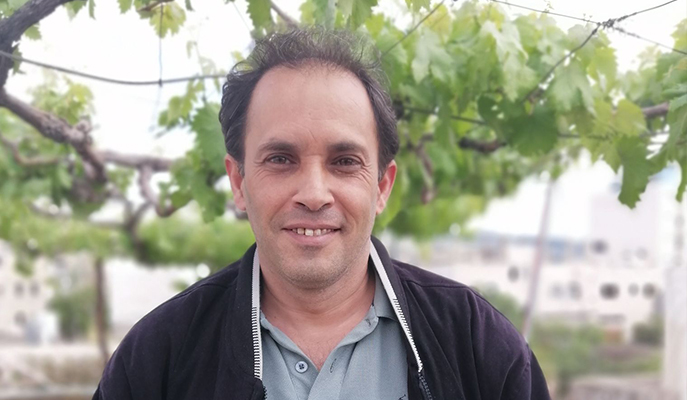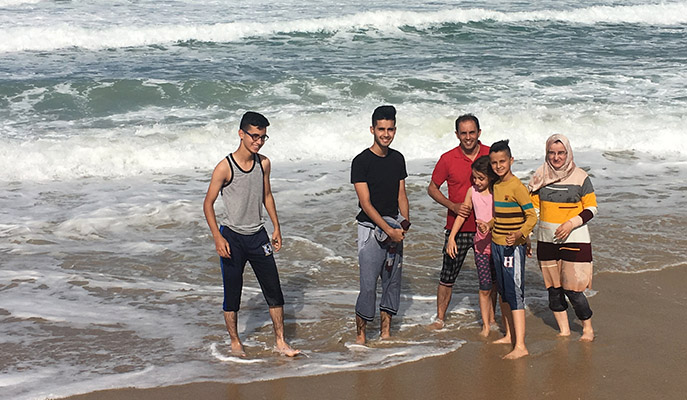Are you a journalist? Please sign up here for our press releases
Subscribe to our monthly newsletter:

For many of us – the hundreds of millions of people quarantined in cities during the corona epidemic – even the parks and public gardens have been off limits. But our loss could be their gain, says Dr. Rafat Qubaja. Even the small urban groves have benefited from lower average temperatures, less air pollution and more shade. Qubaja, a research student who recently finished his PhD, lives in Tarqumiyah, in the Palestinian Authority (PA). He remembers the first time he walked into one of the fruit orchards on the Weizmann Institute of Science. Lugging equipment for measuring, with great accuracy, how the trees interact with their environment, he had little idea that his research would ultimately reveal how even urban groves could play a role in mitigating climate change.
The semi-urban Weizmann Institute orchards cover some ten dunam, all told, and they include lemon trees that were planted in the red, sandy soil of the institute in the 1970s. Qubaja is in the research group of Prof. Dan Yakir of the Institute’s Earth and Planetary Sciences Department, and his mission, at that point, was to measure in detail the expenditure and deposits of water and carbon making up the trees’ “budget.” Qubaja’s measuring system focused on the atmosphere around and above the trees, tracking the exchange of these substances between air and leaves. Among other things, the findings of this study showed that noncommercial citrus groves like these – which receive minimal irrigation – can absorb around 65 kilos of carbon per dunam, per year.

When Qubaja completed his MSc studies in air and water sciences at Al-Quds University in East Jerusalem, he did not entertain, for one second, the idea of continuing his studies in Israel. “My dream was to be a researcher,” he says. “And I was a bit desperate. I might have received scholarships from various institutes around the world, but moving my entire family would have been prohibitively expensive on a PhD stipend. It was Prof. Shlomo Nir of the Hebrew University of Jerusalem, who knew of my work, who said to me ‘Why don’t you consider studying in Israel?’” Qubaja, who is 42 and the father of four children, admits he was at first hesitant. After he was accepted to several PhD programs in Israel, it was, again, Nir who counseled him to join the Yakir’s group at the Institute. “Prof. Nir gave me two pieces of advice, and he didn’t steer me wrong,” says Qubaja.
Still, his first year was far from easy: “I had hoped my family could move to Israel, at least part-time, and that my children could reap the benefits of being at the Institute. But they did not receive the resident visas that would allow that to happen,” he says. Instead, Qubaja split his time between Tarqumiyah and Rehovot, sometimes sleeping in a room on campus during the week and going home to his family on weekends. Most of the time, he makes the daily journey from his home in the PA – a journey that can take three hours to travel around 80 km. First a taxi takes him to the border crossing near Hebron. Just getting from one side of the crossing to the other can take anywhere from ten minutes, on a good day, to over an hour. Then he joins the Palestinian construction workers making the crossing for transport to Kiryat Gat, and from there he gets a bus to Rehovot. “I would not have been able to put up with the hardship of that route if I did not have the full support of Prof. Yakir,” he says. “Add to that the lab team, who are more sisters and brothers to me than colleagues,” he adds. “When I was staying at the Institute, they made sure my room was furnished with everything from a mattress to kitchen tools.”
Why go all the way to Canada, when great science is right next door?
Qubaja is the lead author on no less than four papers that were recently published in leading scientific journals. These are based on measurements from the unique research station operated by Yakir’s group in the Yatir Forest in the Negev. Among other things, this research asks how well semi-arid pine forests like Yatir soak up and store the atmospheric carbon dioxide that contributes to climate change. In one of these papers, he and the research group found that forests in semi-arid regions that dry out in summer can protect themselves from dehydration by absorbing moisture from the atmosphere. It turns out that this survival strategy makes these particular trees good at absorbing and storing atmospheric carbon dioxide, as well. In contrast with forests in wetter regions, these forests tend to store more of their carbon underground (around 70%), and it stays there for longer (on average, 59 years, as opposed to 18 in temperate forests). About 18% of the Earth’s land mass is semi-arid, and if 20% of that were forested, it would trap and store a billion tons of carbon a year. “That might not be enough to save the planet, but it would make a significant contribution to mitigating climate change,” he says.
“When I started my studies, I did not know any other students from the PA studying in Israel,” says Qubaja. “Now there are three or four from my extended family, alone. One cousin is finishing her Master’s at Tel Aviv University. When they come to me for advice, I tell them it is not like what they see on television. No door has ever been closed in my face, and I have always experienced trust between people. In that case, why go all the way to Canada, when great science is right next door?”
Prof. Dan Yakir's research is supported by the Sussman Family Center for the Study of Environmental Sciences; the Cathy Wills and Robert Lewis Program in Environmental Science; Dana and Yossie Hollander; and the Raymond Lapon Fund.